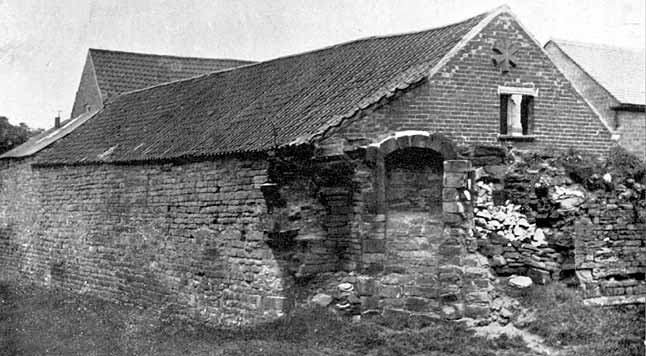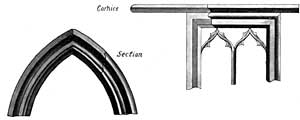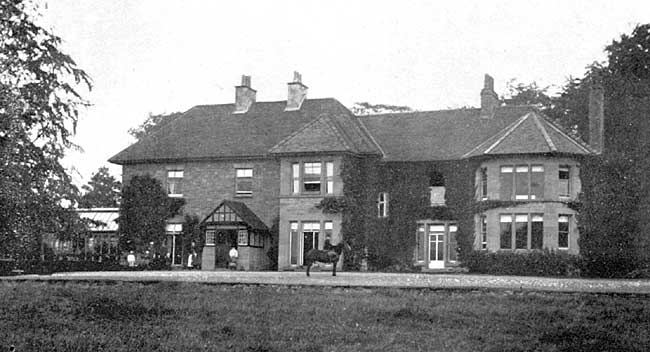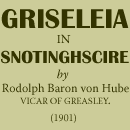< Previous | Contents | Next >

Outbuildings of Greasley Castle Farm containing ancient stonework.
Mr. Isaac Grammer of Nottingham is the present owner of the Greasley Castle Farm, whose tenant Mr. Joseph Renshaw, has considerably improved the condition of the land since he came to it, and carefully preserved every part and object connected with the ancient Castle and its defences.
The basement of the Castle Farm house appears to have been built with materials from the ruins of the Castle, and still contains some fragments of ornamental stone carvings on the front of it.
The outbuildings fronting the Nottingham road are resting on an ancient wall which formed part of the defences of the Castle, and contains the remains of a small ancient sally-port. That wall is now the outer part of stables, &c., on the inside of which (fastened against the wall) are the remains of an ancient arch, and the upper parts of some traceried remains of ancient windows, of which Mr. William George of Moorgreen has been good enough to make us a tracing.
The remains of the entrenchments of the Castle fortifications are in remarkably good condition, and are so carefully preserved that even an unitiated visitor cannot fail to recognise them, together with an apparent porthole for a culliver or other piece of small calibre in the rear of the building.
Tradition says: that the Castle was taken and overthrown during the Civil wars, and considering that Lord Capel, an ardent Royalist, was at that time the owner of the Lordship of Greasley, and that two such men as Gilbert Millington of Felley and Brinsley, and Charles White of Newthorpe, were parishioners of Greasley, and foremost in the interests of the parliamentary party, the tradition may be well founded.

Portions of old windows in the ruins of Greasley Castle.
Lord Capel, like many other royalist noblemen, had elected to loyally take the side of the crown in the unfortunate Monarch’s struggles against the Parliament. After various encounters and marches, he met at last with a serious reverse in the south, and with the remnant of his troops, and accessions which came to him in his march, he threw himself into Colchester, which was strongly fortified to hold out for the King. The parliamentary armies besieged him there, and after a manly and protracted, though hopeless, defence, and under the mistaken impression that the lives of those who surrendered would be spared, he surrendered Colchester to the Parliamentarians. The issue was a sad one. Rapin writes that, notwithstanding Lord Capel’s surrender, he was together with the Duke of Hamilton and the Earl of Holland judged and condemned by a parliamentary Commission, and executed in front of Westminster Hall on the 9th of March, 1649.
The Greasley property afterwards descended to the Earls of Essex, and from them eventually came to the Sutton family, from whom they passed by sale to the House of Melbourne.
Leaving the Castle estates, we propose for a moment to refer to a small piece of land of only a very few perches in dimension, which had traditional interest about it. It was situate at the end of the occupation lane which leads from Mr. John Renshaw’s of Moorgreen to join a public footpath, which leads to Messrs. Barber and Walker’s Co.’s Beauvale Engine yard, and from thence over Cony Grey Farm to Brinsley. The fences of the small piece of ground (through which the footpath leads) have of only very recent years been removed. The piece was called “ Dead man’s land,” while others called it “ No man’s land.” This matter is now nearly, and with many quite forgotten. So far as we could ascertain it, the name had to that piece of land been given from bearers of coffins, and funeral parties from Brinsley on their way to Greasley Churchyard, having usually rested their burden and themselves in that small square.

Lambclose House.
Lambclose is in this township. When Sir Matthew Lamb purchased the Greasley estate from the Sutton family in 1753, Lambclose was a farmhouse, which after some alterations and improvements was fitted up and used as a shooting box. The former farmhouse, or parts of it, are now in the rear of the present Lambclose House, which the Barber family have built and made what it now is. They have occupied it for several generations and repeatedly made improvements in it. The last late Mr. Thomas Barber has much enlarged the house, and tastefully laid out the grounds and shrubberies, &c. The lodge and the fine stables are also owing to him, and the whole forms now a commodious and charming country residence.

Moorgreen reservoir (Photo: A Nicholson, 2004).
The Great Northern Railway Company have a large reservoir here, which when full, is a measured mile in length, and which in severe winters attracts hundreds of people and visitors from far and near to the splendid sheet of ice. The late Mr. Thomas Barber has placed a steam houseboat and smaller craft on the reservoir, and liberally stocked it with trout at a considerable outlay. The large Bazaar for the restoration of the Parish Church in 1882 was held in these charming grounds and surroundings.
